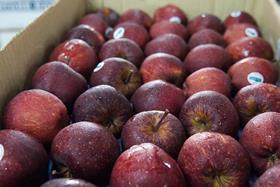
With India’s major apple production areas experiencing smaller than average crops this year– and storage levels looking fairly light– key industry players are expecting strong demand for imports from January/February to July.
In Himachal Pradesh, where the apple season is virtually over, this year’s crop was affected by a protracted dry spell, followed by incessant rain, according to Sanjay Shah of Adani Agrifresh.
“The fruit didn't size up well because of inadequate moisture levels in the soil after a delayed monsoon season,” he explained. “Continuous heavy rain during the second half of the monsoon also caused fruit to drop from the trees prematurely.”
Crop volumes in Himachal Pradesh are put at 17.7m cartons, according to Shah. That figure marks a 30 per cent increase on last year’s low yield of 13.7m cartons, but it’s still down by around 25 per cent on a normal year, he noted.
Figures for production in Jammu & Kashmir will not be available until mid-January when the crop finishes, but latest indications suggest that its volumes are also down on normal levels.
India’s apple storage levels also look relatively low. Shah estimates that total inventories for Himachal Pradesh are barely touching 30,000 tonnes, with around 25,000 tonnes in controlled atmosphere (CA) storage and the remainder in regular cold storage. In Jammu & Kashmir, meanwhile, he estimated CA storage levels at around 5,000 tonnes.
FOB prices of domestic apples opened strongly this year, according to Kumar Dhruva Aggarwal of Dev Bhumi Cold Chain, fetching around US$20 per carton, and they remained firm during the course of the season. “It’s been a good year from that point of view,” he said.
Currently, there is limited demand for imported apples, but this is expected to change in the New Year.
“The present market is not at all aggressive for imported fruits, and importers have lost heavily on Chinese pears, Chinese Red Delicious and Italian kiwifruit while Chinese Fuji and Washington Red apples are yet to start,” said Shah.
“We believe apple imports will pick up from the end of January to early February onwards, but it’s all a price game as our currency is fluctuating all the time and our government is charging duties on much higher prices than the invoice values.”
There are also question marks over the availability of import supplies to meet India’s requirements in 2013.
“Domestic stocks will be virtually empty by late January and we’re going to need a lot of fruit from Washington, but the question is, have they got it?” said Aggrawal. “They’re peaking on large sizes, such as 72s and 80s, whereas the main demand here is for 100s, 113s and 125s. We might just have to buy larger sizes from Washington this year.”
With Washington apple prices expected to be much higher this year due to domestic shortages in the US, Shah believes there could be opportunities for Chinese Fuji to shine.
“In Shandong Province, the Fuji crop is up 5-10 per on last season and the size curve is more favourable, with a higher percentage of 80s, 88s, 100s and 113s. Prices are similar to last season at the moment but we believe they’ll come down a little by January,” he said.
“Looking to the very high prices of Washington apples, which are up 10 per cent on last season, Chinese Fuji have a big opportunity this season, which will run from January to mid-July.
Aggarwal sees a potential shortage of red apples on the market in March/April if sufficient supplies of Washington Red Delicious cannot be secured.



